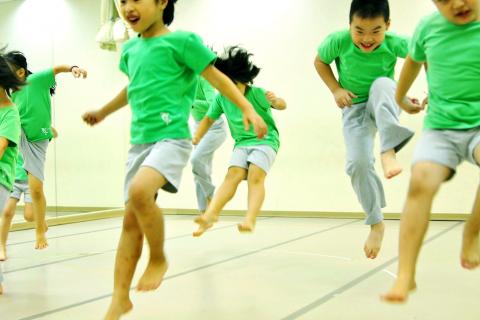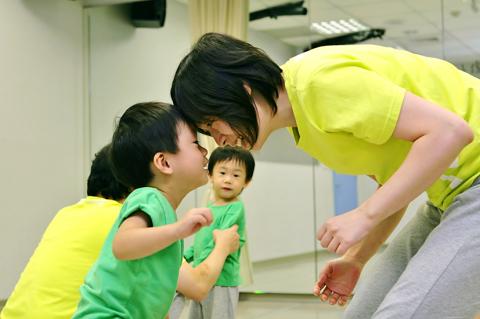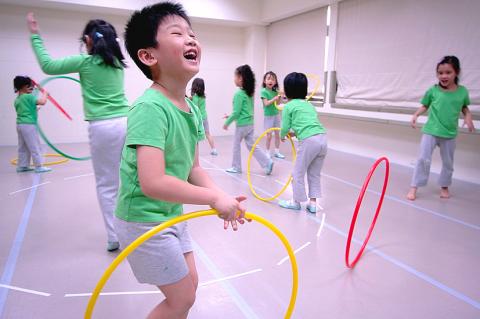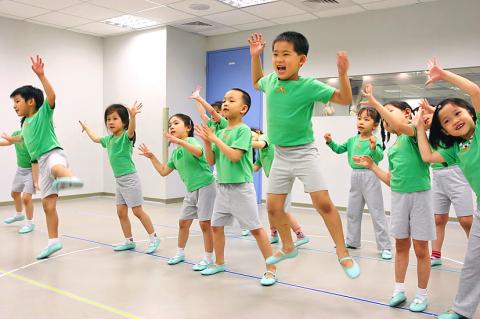Cloud Gate Dance School (雲門舞集舞蹈教室) is not actually a dance school at all. Its aims extend far beyond teaching people to dance; in fact, according to the school’s director of research and development Hsieh Ming-fei (謝明霏), dance training is the least of her concerns. “It is about changing the physical culture of Taiwanese,” she said, speaking to the Taipei Times in a classroom at the school’s Guting branch. The school is celebrating its 15th anniversary this year, and has developed from being an oddity in the intensive education environment of Taiwan, to a hugely popular institution with students from age three to 73.
“When we were young, our education was very formal. Added to that, Chinese culture does not encourage physical contact, even between parents and children … As a dancer, even from a very young age, I became more comfortable with my own body and with physical contact, and I realized that physical communication is a very direct form of communication. Its expressive power can be much greater than words,” Hsieh said, a professional dancer who is now responsible for curriculum development at Cloud Gate Dance School.
“When I was young, people would often say ‘you dancers are very sui-bian (隨便),’ meaning that we hugged or kissed openly, but that really isn’t the point. Physical contact is a way of expressing love and concern for those you care about. Of course, things are changing now, but it is a gradual process. As dancers, we probably have a closer connection with our bodies than other people, and we wanted to share this knowledge with other people,” Hsieh said.

Photo courtesy of Cloud Gate Dance School
Cloud Gate Dance School has classes for children as young as three, and emphasizes that parents should participate in these classes, making them a mutual learning process. At the other end of the spectrum, there are classes for the elderly, teaching them to be more comfortable and more confident about their bodies. For young people, there are some more technical dance and martial arts classes that teach greater physical control.
“A lot of it is about confidence and the ability to relax,” Hsieh said. “When we joined Cloud Gate, even though we were already all grown up, we still needed Lin Hwai-min (林懷民, founder of Cloud Gate Dance Theatre) to tell us that we needed to present ourselves with confidence. Thinking back, it may be that Chinese culture over-emphasizes humility at the expense of confidence … It is a feature of Chinese culture that has both a good side and a bad side, and while we might be modest, it also makes us less able to express ourselves,” Hsieh said. For Hsieh, the primary aim of all the classes at the dance school is to redress that balance.
A particularly important part of what Cloud Gate Dance School tries to achieve is to develop a joy in physical activity and contact, and this is particularly apparent in children’s classes, which emphasize play. “We want to convey a joy in physical activity and contact with the physical world,” Hsieh said, pointing out to the use of all kinds of found props, including newspapers and cardboard boxes, which become valuable teaching tools as little kids find ways of making these into toys.

Photo courtesy of Cloud Gate Dance School
While most of the teachers at the school are professional dancers, Hsieh pointed out a terrible irony in Taiwan’s formal dance education that she finds particularly saddening.
“Formal education is such a high-pressure environment in Taiwan,” Hsieh said.
“Everything is about scores, and at dance school, the focus is in getting a good place at university … Many of the schools use really harsh methods to make sure their students progress, so much so that many students drop out of dance soon after they graduate. They have simply lost all their passion for dance.”

Photo courtesy of Cloud Gate Dance School
According to her mother, 14-year-old Li Ya-hsuan (李亞璇) might have stopped going to Cloud Gate’s dance class, as she considered the prospect of a junior high school workload. But Li, who aspires to be a professional dancer, told her mother that Cloud Gate was a “weekly boost to her passion for dance.”
“Dance encompasses all movement. As professional dancers, the simplest movement is part of dance. People need to understand that dance covers a huge spectrum, it’s not just ballet. Everyone can dance ... Children love to dance, and we want to preserve this passion into later life,” Hsieh said. As a result, technical achievement is much less a priority than spontaneous expression and a connection with one’s own body.
From its beginnings 15 years ago as a single class aimed at infants, Cloud Gate Dance School has completed a cycle of development that has seen vast changes in the community at large. “We now deal with a whole new generation of students and parents,” Hsieh said, “and our approach is constantly changing.”

Photo courtesy of Cloud Gate Dance School

Photo courtesy of Cloud Gate Dance School

With the inauguration of the Democratic Progressive Party’s (DPP) William Lai (賴清德) today, the DPP has already announced plans for increased social spending. Meanwhile the Chinese Nationalist Party (KMT) is pushing east coast infrastructure spending bills through the legislature, in part to feed and water its local patronage networks. The KMT plan is old: the first planning studies for it were done in 2012 under the Ma Ying-jeou (馬英九) administration. Even then the head of the highway administration, Wu Meng-feng (吳盟分), pointed out that on a typical weekday only 20 percent of the capacity of the east coast highways 9

Gaotai Mountain (高台山) and the three Daotian Peaks (小中大島田山回來) afford visitors a truly rewarding hike in Hsinchu County (新竹). Located in the foothills just beyond the charming Neiwan Old Street (內灣老街), the hike is well suited for hikers in a fair to good physical condition. It’s also a good introduction to the foothills of northwest Taiwan, along with some more adventurous — but still not terribly dangerous — rope and scrambling sections. As a bonus, there are Japanese ruins, hot springs and river tracing destinations such as Meihua Waterfall (梅花瀑布) and Bilin Waterfall (比麟瀑布) all located nearby. WHISPERING PINES The first section of

Like many young Taiwanese men who recently graduated from university, George Lee (李芳成) isn’t quite sure what he’ll do next. But some of his peers surely envy what he’s already achieved. During the pandemic, while staying with his brother in California, Lee started an online food page, Chez Jorge. At first, it was a straightforward record of what he cooked each day, with many of the dishes containing meat. Lee soon began to experiment with plant-based dishes, specifically vegan versions of Taiwanese dishes he was already familiar with. “Very often, I found myself awed by not only how delicious they were,

May 20 to May 26 The two American HU-16 seaplanes hovered helplessly above the roaring waves, unable to save their seven comrades who had parachuted into the Pacific Ocean after their plane malfunctioned. As they were discussing the next plan of action over the airwaves, a Taiwanese plane overheard the conversation and told them to contact Chin Moon Fun (陳文寬) — “because that guy can land a plane on any water surface!” On March 18, 1954, Chin, who co-owned Foshing Airlines (復興航空, renamed TransAsia in 1992), hurriedly flew one of the company’s two amphibious PBY Catalina planes to the scene. Even though